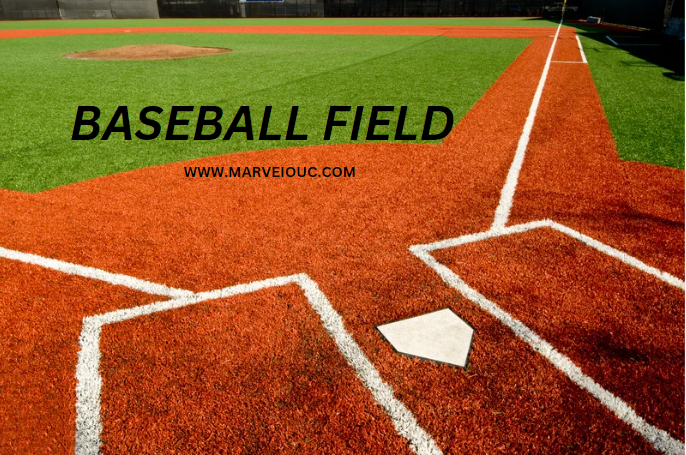Baseball Field
Baseball field have a wide range of lines and markings that assume an essential part in the sport of baseball. Nonetheless, there are additionally significant contrasts in the general elements of the field contingent upon the age of the members.
Considering this, we have made a complete outlined guide itemizing every one of the aspects and markings you can hope to see on a baseball field. The aide frames how the aspects change from the MLB (Significant Association Baseball) to Youth Baseball, secondary school baseball, school baseball, and the different Horse Association age gatherings, including baseball field graphs for each.
In the wake of perusing this guide, you ought to have the option to comprehend the various parts of a baseball field and line a field with certainty.
BASEBALL FIELD Designs
The general design of a baseball field doesn’t change between the different expertise levels and ages In this part, we’ll go through the aspects and field lines you’d hope to see on the infield and outfield of a baseball field.
BASEBALL INFIELD Aspects AND LINES
The infield of a baseball field is where the jewel, bases, home plate, pitcher’s hill, and the start of the foul lines are found. This is where the pitcher will toss the ball towards the player, who will hope to stir things up around town and go around the 4 bases situated around the jewel. Underneath we’ve recorded every one of the parts of the infield, giving the elements of each.
The Jewel
The jewel is a square that actions 90ft/27.4m on all sides. Players go around the blueprint of the precious stone whenever they have stirred things up around town, concluding whether they need to stop at a base or whether they can make it the entire strategy for getting around for a ‘homer’.
Bases in Baseball Field
In baseball, there are three bases known a respectable starting point’, a respectable halfway point’, and a third base’. They are situated on each side of the jewel. The player running should contact each base before scoring a run at the home plate. The bases are frequently made of a white rubbery material or a white material that should be affixed safely to the ground. Each base should quantify 18 creeps on all sides to adjust to MLB guidelines. An update to the principles in September 2022 expanded the base sizes from 15 crawls up to 18 creeps to decrease the gamble of crashes between hitters running and the basemen. The ‘basemen’ are defenders who are situated on the bases to label out hitters with the ball before the player can arrive at the base.
Also Read: BulletBall
Home Plate
The home plate is the last base that frames the jewel and is found 127ft 3in/38.8m inverse a respectable halfway point. The hitter or ‘base sprinter’ should run a full circuit of the bases and arrive at the home plate to score a run for their group. These bases are situated at 90-degree points from the home plate.
Foul Lines
The foul lines somewhat frame the field of play. They reach out from the player’s crate to the foul posts profound into the outfield on each side of the field.
Baselines
The baselines are straight in the middle between every one of the bases that are 90ft/27.4m long. The baselines between a respectable starting point and a respectable halfway point, undetectable halfway point, and third base aren’t set apart on a baseball field. In any case, the baselines between the home plate and a respectable starting point, and between third base and the home plate, cross over with the foul lines.
Running Path
The running path is a three expansive path set apart by a 45ft long queue painted onto the field lined up with the foul line and a respectable starting point. It is utilized as an aide for players running towards the respectable starting point from the home plate. The hitter should keep the two feet inside the or on the lines of the running path. The player running is permitted to step beyond the running path when near a respectable starting point by making an enormous stride or sliding. Be that as it may, when beyond the running path, sprinters should not slow down the play any other way the umpire will require an impedance and the sprinter included will be called out.
Player’s Crate
The player’s crate is the region at the home plate where the hitter will take a position when they are at batThe container to the right half of the home plate is for passed on given players and the crate to the left side is for right-gave hitters.
When the pitcher starts their tossing movement, the player can’t leave the hitter’s case. In any case, they can call a break among pitches and leave the container briefly.
Catcher’s Case
There are two mentors’ cases situated on a baseball field, one external the foul lines by a respectable starting point and the other external the foul lines by third base. The cases measure 15ft/4.6m by 35ft/10.7m and mentors from the batting group will be remained in the two boxes. The mentors should wear head protectors and stay inside the cases. Mentors will guide the base sprinters and once in a while trade gear like sliding gloves or defensive dress.
Mentors’ Case
There are two mentors’ cases situated on a baseball field, one external the foul lines by a respectable starting point and the other external the foul lines by third base. The cases measure 15ft/4.6m by 35ft/10.7m and mentors from the batting group will be remained in the two boxes. The mentors should wear head protectors and stay inside the cases. Mentors will guide the base sprinters and at times trade hardware like sliding gloves or defensive apparel.
Pitcher’s Hill
The pitcher’s hill in baseball is a brought area of soil up in the focal point of the jewel containing the pitcher’s elastic, from where a pitcher tosses. The pitcher’s elastic is a little square shape of white elastic inside the hill estimated 2ft by 6 inches and is 60ft 6in away from the home plate, which structures what is known as the ‘pitching distance’. The elastic should be found 10in over the ground and put 18in behind the focal point of the hill, which is raised inside an 18ft distance across the circle.
BASEBALL OUTFIELD Aspects
The outfield of a baseball field is the open area of turf past the infield. The limits of the outfield are set apart by the foul lines which should expand at least 320ft/97.5m on each side of the field from the hitter’s cases.
Not at all like the elements of the infield, the outfield’s aspects can fundamentally change starting with one baseball park and then onto the next – even at the expert level. The most profound piece of any baseball outfield is known as the ‘centerfield’ which normally gauges something like 400ft/121.92 in an upward direction from the home plate on most MLB fields. Comerica Park in Detroit has the most profound centerfield wall in the MLB at 420ft/128m and Fenway Park in Boston has the shallowest centerfield wall at 390ft/118.9m.
The regions on either side of the middle field are known as the ‘left field’ and the ‘right field’. These regions ordinarily measure between 320ft/97.5m and 350ft/106.7m on most MLB fields. The most profound right field in the MLB is Wrigley Field in Chicago at 353ft/107.6m, with the shallowest right field found at Fenway Park estimating 302ft. Similar two stops additionally have the most profound and the shallowest left handles estimating 355ft/108.2 and 310ft/94.5m individually.
The outfield is the thing the players are hoping to clear when they are stirring things up around town. If fruitful and the ball is hit beyond the walls without bobbing, and stays inside the foul lines, then, at that point, this is known as a ‘grand slam’ and the player can go around every one of the bases without being labeled out.
Defenders are likewise situated inside the wide, open space that is the outfield. These ‘out-defenders’ will hope to get players out as well as toss the ball to the base defenders as fast as conceivable to attempt to get hitters labeled out.
Youth BASEBALL FIELD Aspects
Youth Baseball is an association that set up nearby youth baseball associations all through the US and the remainder of the world. There are different age sections and capacity divisions inside Youth baseball, and the field size and throwing distance for some of the age bunches is more modest than an expert MLB field as the more youthful players can’t toss or raise a ruckus around town as hard as expert players. It is vital to take note of that aspect given for the size of the jewel or contributing distance specific divisions are the most extreme sizes that they can be, and the particular neighborhood association has the choice to decrease them at their caution. The extent of the centerfield and left/right field will rely upon the size of every baseball park, however, the base size prerequisites suggested by Youth Baseball are incorporated underneath.
School Baseball Field Aspects
The elements of a school (NCAA) baseball field are the same as that of an expert MLB field. The infield comprises a 90ft-by-90ft precious stone and a pitching distance of 60ft and 6in, as in MLB.
The suggested distances for the outfield are 400 feet from the home plate to the centerfield and a base off 330 feet from the home plate to the furthest limit of the foul lines, with the walls balanced to match the suggested distances. As referenced before, every baseball park is unique, consequently why suggested distances are given.
Secondary School Baseball Field Aspects
Like a school baseball field, the components of a secondary school field are practically indistinguishable from those on an MLB field. The infield is the very same, with a 90 ft-by-90 ft precious stone and a 60ft 6in long pitching distance.

